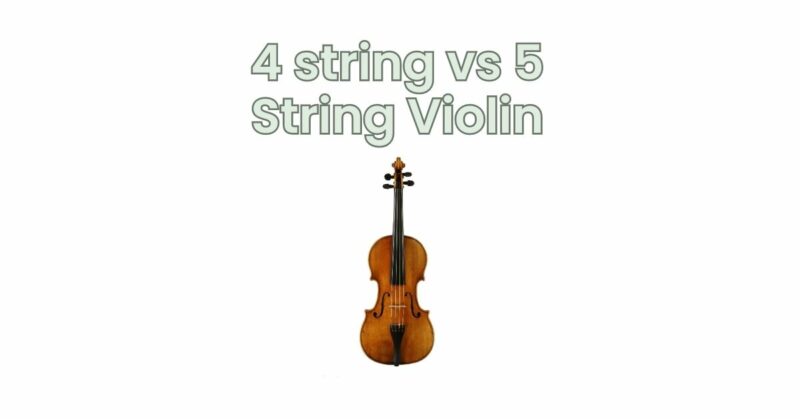The violin is a versatile and expressive instrument, known for its beautiful sound and wide range of musical possibilities. While the standard configuration of a violin consists of four strings, some musicians and luthiers have embraced the idea of adding a fifth string. In this article, we will compare the 4-string and 5-string violins, exploring their differences, advantages, and considerations for musicians looking to choose between these two configurations.
4-String Violin:
The 4-string violin is the traditional configuration, consisting of four strings tuned to G, D, A, and E. Here are some key characteristics and advantages of the 4-string violin:
- Standard Repertoire:
- The 4-string violin is the foundation of classical violin repertoire, with a vast body of music written specifically for this configuration.
- It is the most common and widely recognized form of the instrument, making it easier to find sheet music, tutorials, and resources.
- Familiarity and Tradition:
- The 4-string violin has a long-standing tradition and is the instrument of choice for many classical violinists.
- Musicians who appreciate the rich heritage of the instrument and want to maintain a traditional approach often opt for the 4-string configuration.
- Portability and Ease of Use:
- The 4-string violin is relatively compact and lightweight, making it easy to carry and transport.
- Its standard size and shape facilitate proper playing technique and familiarity with fingerboard positions and intervals.
5-String Violin:
The 5-string violin is an extended configuration that adds a fifth string to the traditional setup. This additional string provides unique advantages and musical possibilities:
- Extended Range:
- The primary advantage of the 5-string violin is the addition of a lower-pitched string, which expands the instrument’s range.
- This extended range allows for playing lower notes and exploring new tonal textures not easily accessible on a 4-string violin.
- Chordal and Harmonic Capabilities:
- The fifth string provides additional options for creating chords and harmonies, adding depth and complexity to musical arrangements.
- It enables violinists to achieve richer chord voicings and explore unique harmonic possibilities.
- Genre Flexibility:
- The 5-string violin is particularly suited for genres such as jazz, folk, and contemporary music that benefit from its extended range and versatility.
- Musicians seeking to explore a wider range of musical styles may find the 5-string violin more suitable for their creative endeavors.
Considerations for Choosing Between 4-String and 5-String Violins:
When deciding between a 4-string and a 5-string violin, consider the following factors:
- Musical Preference and Repertoire:
- Determine the style of music you wish to play and assess whether it aligns more with the traditional classical repertoire or explores extended ranges and genres.
- Technical Adaptation:
- Keep in mind that playing a 5-string violin requires some adjustment to finger placement, bowing technique, and overall familiarity with the instrument.
- Evaluate your comfort level and willingness to adapt to a modified configuration.
- Availability and Resources:
- Consider the availability of sheet music, tutorials, and resources specific to the chosen configuration.
- The 4-string violin benefits from a wealth of established materials, while the 5-string may require more specialized resources.
- Personal Artistic Vision:
- Reflect on your personal artistic vision and the musical goals you wish to achieve.
- Determine whether the extended capabilities and tonal possibilities offered by the 5-string violin align with your creative aspirations.
Conclusion:
The choice between a 4-string and a 5-string violin ultimately depends on personal preference, musical goals, and the desire to explore extended tonal ranges. The 4-string violin has a long-standing tradition, a wide range of classical repertoire, and familiarity for musicians seeking a traditional approach. On the other hand, the 5-string violin provides an expanded range, enhanced chordal capabilities, and genre flexibility. Consider your musical preferences, technical adaptability, availability of resources, and personal artistic vision when making the decision. Both configurations offer unique musical possibilities and can be rewarding to explore, so choose the violin that aligns best with your musical journey and aspirations.


